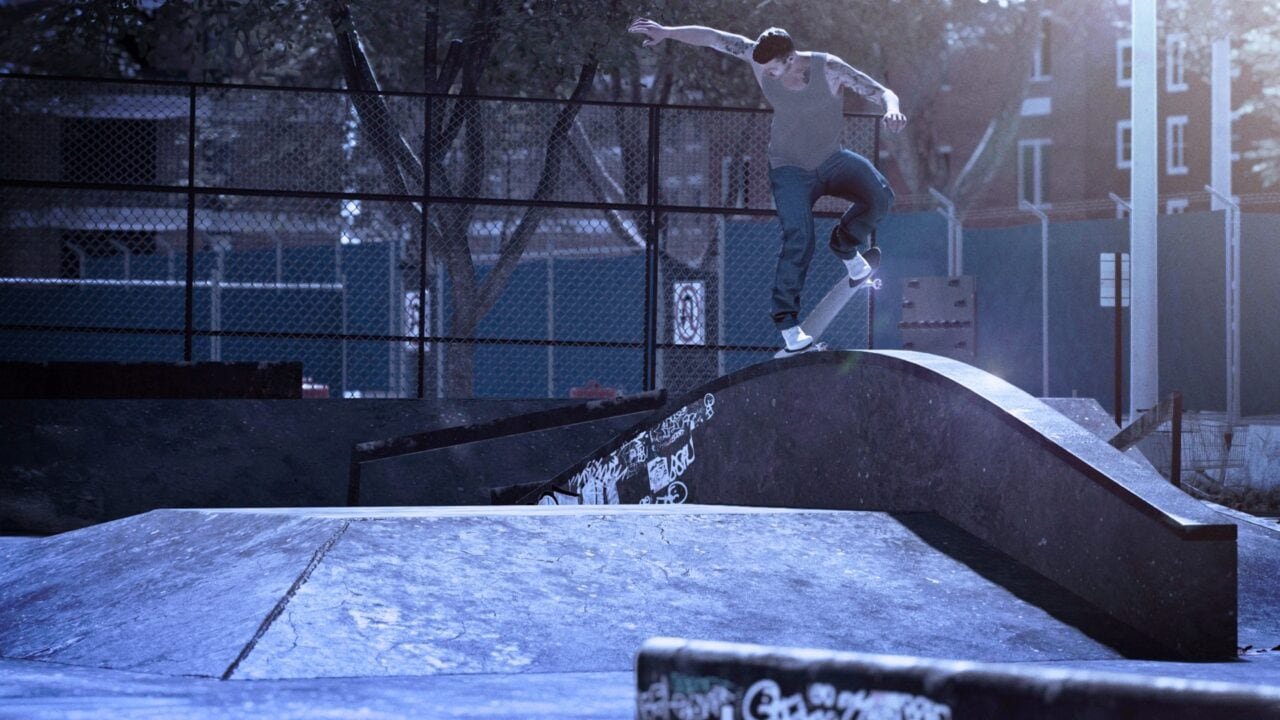Skating video games have been around since the Atari’s 720—named after the largest spin landed on a skateboard at the time—and when Tony Hawk not only shattered the record by landing his famous 900, Tony Hawk’s Pro Skater revolutionized skating games with phenomenal game mechanics, arcade scoring fun, and a killer soundtrack. Session: Skate Sim removes all the arcade, and unrealistic arcade fun the pro skater titles brought, and turns the difficulty dial up to 11.
Session: Skate Sim begins with a very barebones character creator and customization screen to get you going, and once you start, the indoctrination happens. The storyline is a simple one, another character is ‘re-teaching’ you the basics on how to skate after you made an epic bail that sidelined the player from competing for 10 years. But, besides the fun jokes your friends hit you with regarding your legendary fall from grace, the storyline is skippable.
The real meat of Session: Skate Sim gameplay are the controls. The left analog stick controls the players left foot, while the right stick controls the right foot. Skaters can hold or tap the ‘push’ buttons to skate forward, and the triggers steer the board. This control scheme—as someone who grew up with the Tony Hawk games—is incredibly difficult to get a handle on. But with this difficulty, comes the same feeling of accomplishment as landing tricks in real life. The learning curve of this title can bring players back to their glory years trying to learn how to simply ollie on a skateboard, and the ankle pain that comes with it. Also like in real life, almost any tutorial without actually feeling how it is, will feel VERY incomplete.
The stick controls are extra sensitive too, a half tilt from down to the right on the right analog while playing with the ‘standard stance’ allowed me to kick the board into a pop-shuvit. While it felt exciting to land anything—take that high school!—the tricks demand rigorous and flawless control. I felt it was far too easy to ‘accidentally’ do a 360-shuvit. Manuals require rigid execution as well, the player must hold the stick halfway tilted downward on the back foot to perform one, and while performing a string of tricks which may take players a LONG time to be able to do focus is difficult to maintain. Pop height, positioning, and pretty much all actions are subject to the extreme criteria Session requires of the player.
“It’s worth mentioning Session allows for almost complete freedom and creativity to skate how the player desires and that’s a cool concept.”
The game’s premise is simple, you can explore locations in Philadelphia, New York, and San Francisco that are all accessible by bus stop fast travel points at any given time. It’s worth mentioning Session allows for almost complete freedom and creativity to skate how the player desires and that’s a cool concept. There are of course ‘missions’ the player can partake in, given by other skaters, which are basically ‘do this trick down these stairs!’ rinse and repeat.

Completing missions gives the players EXP (exposure) which can advance career ranks all the way to pro (I didn’t make it that far). It also helps the missions are given by real life professional skateboarders which helps with immersion, Donovan Strain hands out assignments with an iron fist, and some humour.
While all these things are welded together by ‘go here and perform this trick here,’ and other similar quests, it is genuinely fun to try and explore the locations while riding around on your board. Inclusions of real-life skate brands like Fallen and Zero brought nostalgia and attention to detail with them, and flashing back to my angsty teen days where DC shoes were the cool things to wear was unavoidable. But, besides the awesome nostalgia, this game has problems.
“Session: Skate Sim has a great premise but falls short in many categories for a title that has been in development for many years.”
During missions, Session: Skate Sim demands perfection out of the player but doesn’t give it in return. Too many times I was asked to manual on a ledge, for the skater to automatically latch onto the ledge in a grind motion. A simple design flaw like this can usually be overlooked, but it blankets many of the areas in Session. Wall riding feels extremely clunky and un-usable for me, as well as certain trick inputs.
Some of the more advanced tricks require Street Fighter Shoryuken inputs, on both sticks which just feels uncomfortable. Also, this may be an issue for just me, but there is no setting to show which trick the player performs on screen. Having validation of correct performance for such a hard title almost feels necessary.

Speaking of which, on easier difficulties, the title felt much harder and vise versa. There are just general gameplay issues that stops Session: Skate Sim from truly feeling complete, barely touching certain ledges can make the player fall over, and it is generally just too sensitive and demands too much total control in a title that doesn’t deliver the same excellence demanded of the person on the board.
Session: Skate Sim has a great premise but falls short in many categories for a title that has been in development for many years. Landing tricks and succeeding in gameplay aspects grants a rewarding feeling that matches beating hard boss enemies in Elden Ring, but inconsistent play adds to a frustrating control scheme that demands flawless performance. The controls can be fixed a bit in the menus, with gravity adjustments, and other tinkering that can provide comfort. In an unsaturated skate simulator market, Session: Skate Sim has a chance to be a beacon of hope for fans of skating, but just bails before landing.

Be the first to comment